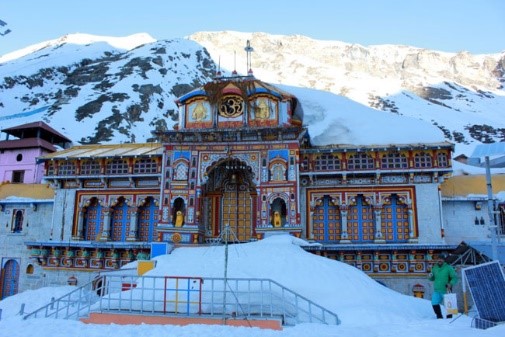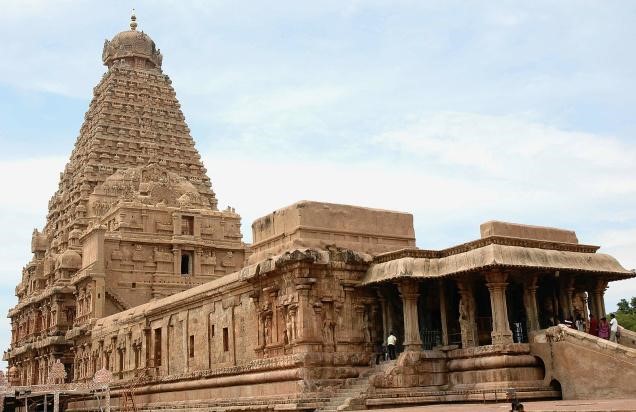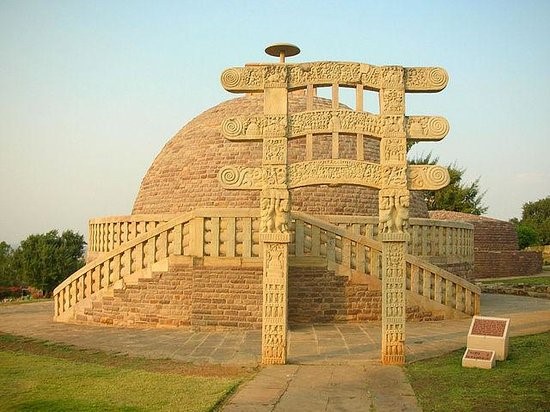Some of the most famous temples in India

Situated close to the Alaknanda River, the abode of Lord Badrinath is located in the Chamoli district, a small town of Badrinath (Uttarakhand). This holy shrine of Lord Vishnu forms a part of the four holiest sites (Char Dhams) in Hindu religion. It is also one of the four Chota Char Dham pilgrimage sites (comparatively minor pilgrimage sites). It is one of the 108 temples dedicated to Lord Vishnu (Divya Desams), which find mention in the works of Tamil saints who existed from 6th to 9th century. It is one of the most visited pilgrimage centres of India, having recorded 1,060,000 visits. The image of the presiding deity worshipped in the temple is a 1 m (3.3 ft) tall, black stone statue of Vishnu in the form of Badrinarayan. The statue is considered by many Hindus to be one of eight swayam vyakta kshetras, or self-manifested statues of Vishnu.

Brihadeeswara Temple is a Hindu temple dedicated to Siva Peruman located in Thanjavur in the Indian state of Tamil Nadu. It is also known as RajaRajeswara Temple Rajarajeswaram and Peruvudayar Temple. It is one of the largest temples in India and is an example of Dravidian architecture during the Chola period. Built by Raja Raja Chola I and completed in 1010 CE, the temple turned 1000 years old . The temple is part of the UNESCO World Heritage Site known as the "Great Living Chola Temples", with the other two being the Peruvudaiyar Temple, Gangaikonda Cholapuram and Airavatesvara temple. The temple stands amidst fortified walls that were probably added in the 16th century. The vimanam (temple tower) is 198 ft (60 m) high and is one of the tallest in the world. The Kumbam (the apex or the bulbous structure on the top) weighs around 80 tons. There is a big statue of Nandi (sacred bull), carved out of a single rock measuring about 16 ft (4.9 m) long and 13 ft (4.0 m) high at the entrance. The entire temple structure is made out of granite, the nearest sources of which are about 60 km to the west of temple. The temple is one of the most visited tourist attractions in Tamil Nadu.

The Somnath temple located in Prabhas Patan near Veraval in Saurashtra on the western coast of Gujarat, India, is believed to be the first among the twelve jyotirlinga shrines of Shiva. It is an important pilgrimage and tourist spot of Gujarat. Destroyed and reconstructed several times in the past, the present temple was reconstructed in Chalukya style of Hindu temple architecture and completed in May 1951. The reconstruction was envisioned by Vallabhbhai Patel and was completed under K. M. Munshi, the then head of the temple trust. The site of Somnath has been a pilgrimage site from ancient times on account of being a Triveni sangam (the confluence of three rivers — Kapila, Hiran and the mythical Sarasvati). Soma, the Moon god, is believed to have lost his lustre due to a curse, and he bathed in the Sarasvati River at this site to regain it. The result is the waxing and waning of the moon, no doubt an allusion to the waxing and waning of the tides at this sea shore location. The name of the town Prabhas, meaning lustre, as well as the alternative names Someshvar and Somnath ("The lord of the moon" or "the moon god") arise from this tradition. This is one of the oldest pilgrimage centres in India and finds mention in the ancient books, like Shivpuran, Skandpuran and Shreemad Bhagvat. Som refers to the ‘Moon God’, thus Somnath means ‘Protector of the Moon God’. According to a legend, Som got the temple built in the honor of Lord Shiva as it was Shiva who cured the illness, which was inflicted on him due to his father-in-law’s curse. It is one of the most revered ‘jyotirlings’ among the 12 existing jyotirlings of India. The temple is located in Prabhas Kshetra in Saurashtra (Gujarat). Prabhas Kshetra is also the region in which, it is believed that, Lord Krishna left his mortal body. Another interesting thing about the place is that it is built on the shore of Arabian Sea and in between the temple and the South Pole, in a straight line there is no land area. Somnath temple was destroyed and re-built many times. The place also has a Somnath museum, Junagadh gate, beach and a sound and light show to amuse the pilgrims.

Kēdārnāth Mandir (Kedarnath Temple) is a Hindu temple dedicated to Lord Shiva. It is on the Garhwal Himalayan range near the Mandakini river in Kedarnath, Uttarakhand in India. Due to extreme weather conditions, the temple is open only between the end of April (Akshaya Tritriya) to Kartik Purnima (the autumn full moon, usually November). During the winters, the vigrahas (deities) from Kedarnath temple are brought to Ukhimath and worshiped there for six months. Lord Shiva is worshiped as Kedarnath, the 'Lord of Kedar Khand', the historical name of the region. The unstable temple is not directly accessible by road and has to be reached by a 14 kilometres (8.7 mi) uphill trek from Gaurikund. Pony and manchan service is available to reach the structure. The temple was built by Pandavas and revived by Adi Sankaracharya and is one of the twelve Jyotirlingas, the holiest Hindu shrines of Shiva. It is one of the 275 Paadal Petra Sthalams, expounded in Tevaram. Pandavas were supposed to have pleased Shiva by doing penance in Kedarnath. The temple is one of the four major sites in India's Chota Char Dham pilgrimage of Northern Himalayas. This temple is the highest among the 12 Jyotirlingas.[2] Kedarnath was the worst affected area during the 2013 flash floods in North India. The temple complex, surrounding areas and Kedarnath town suffered extensive damage, but the temple structure did not suffer any "major" damage, apart from a few cracks on one side of the four walls which was caused by the flowing debris from the higher mountains. A large rock among the debris acted as a barrier, protecting the temple from the flood. The surrounding premises and other buildings in market area were heavily damaged. Situated in the Himalayan range of Garhwal area (Uttarakhand), Kedarnath temple is one of the most sacred Shiva temples in the world. This holy abode of Shiva is said to be built by the Pandavas to atone for their sins committed during their battle with Kauravs. The temple was restored by Adi Sankaracharya in 8th century. It is one of the Chota Char Dhams of Uttarakhand and requires a pilgrim to walk a distance of 14 kms over the hilly surface. One can make use of a pony or manchan to simplify the journey.

Sanchi is a village in the Raisen district of Madhya Pradesh, which is a home to several Buddhist structures built in between 3rd century BC to 12th century AD. The most significant of them all is the Sanchi Stupa, also known as the Great Stupa. A Stupa is a holy place of Buddhist, which is built in the shape of a dome that consists of relics of Buddha. A UNESCO World Heritage Site this famous pilgrimage site in India was built by the great emperor Asoka in the 3rd century BC. There are four intricately designed gateways surrounding the Stupa known as Toranas, each individually symbolizing the four emotions of love, peace, courage and trust. The Great Stupa is 16 meters high and 37 meters in diameter and preserves the relics of Buddha.

Ramanathaswamy Temple is a Hindu Temple dedicated to the god Shiva located on Rameswaram island in the state of Tamil Nadu, India. It is also one of the twelve Jyotirlinga temples.It is one of the 274 Paadal Petra Sthalams, where the three of the most revered Nayanars (Saivite saints), Appar, Sundarar and Tirugnana Sambandar, have glorified the temple with their songs. The temple was expanded during the 12th century by Pandya Dynasty, and its principal shrines sanctum were renovated by Jeyaveera Cinkaiariyan and his successor Gunaveera Cinkaiariyan of the Jaffna kingdom. The temple has the longest corridor among all Hindu temples in India.[1] The temple is located in Rameswaram considered a holy pilgrimage site for Shaivites, Vaishnavites and Smarthas. The presiding deity, the Lingam of Ramanathaswamy (Shiva), is believed to have been established and worshiped by Rama, an avatar of the god Vishnu, to absolve the sins created during the Ramayana war at Sri Lanka. Rameshwaram is a small island town in Tamil Nadu and is one of the four holiest pilgrimage places (Char Dhams) of the Hindus.

Located in the ancient and holy city of Varanasi (Uttar Pradesh), Kashi Vishwanath temple is dedicated to Lord Shiva, also referred to as Vishwanath or Vishweshwara, meaning emperor of the universe. The city of Varanasi is also known as Kashi that is why the temple is famously called Kashi Vishwanath temple.The distinguished temple has been visited by many great holy men like Swami Vivekanand, Adi Shankaracharya, Goswami Tulsidas and Gurunanak. The merit or the blessings received from sighting jyotirling at Kashi Vishwanath is equal to that earned from visiting the rest of the 11 jyotirlings placed at several areas in India. A visit to the sacred temple of Shiva is believed to be one of the ways through which one can attain Moksha (ultimate liberation of the soul). The temple has been mentioned in the Puranas including the Kashi Khanda (section) of Skanda Purana. The original Vishwanath temple was destroyed by the army of Qutb-ud-din Aibak in 1194 CE, when he defeated the Raja of Kannauj as a commander of Mohammad Ghori. The temple was rebuilt by a Gujarati merchant during the reign of Delhi's Sultan Iltutmish (1211-1266 CE). It was demolished again during the rule of either Hussain Shah Sharqi (1447-1458) or Sikandar Lodhi (1489-1517).